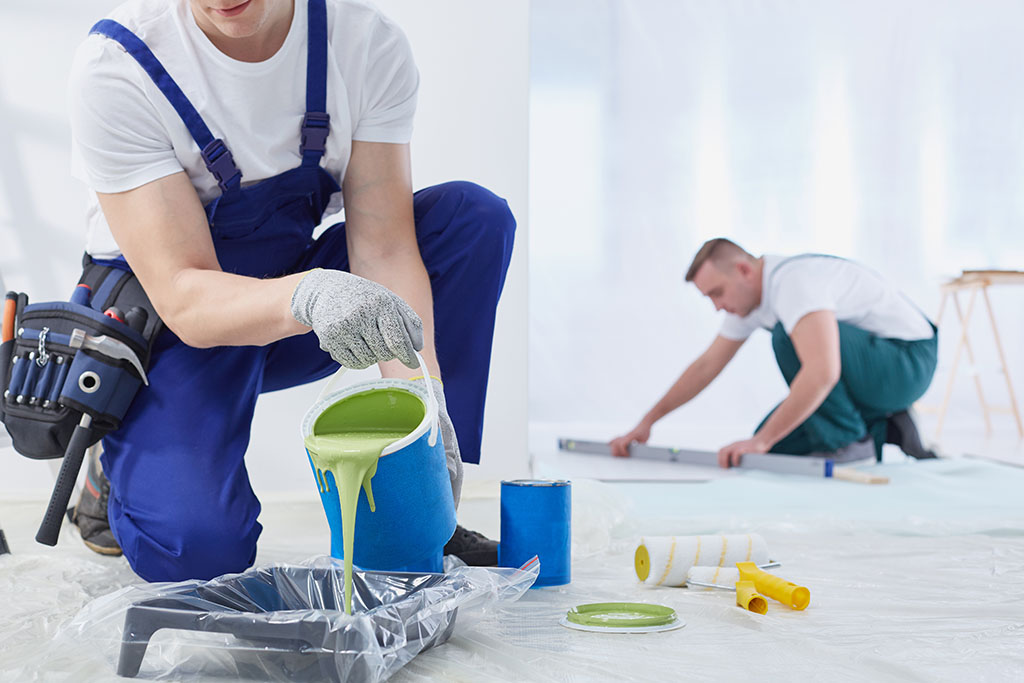Checking Out the Different Kinds of Paint: An Overview for each Project
Exploring the different sorts of paint is essential for achieving the wanted end result in any kind of project. From water-based choices that use convenience to oil-based paints known for their sturdiness, each choice has its merits. Specialty paints can include one-of-a-kind structures or surfaces, while green choices deal with those seeking sustainability. Understanding these differences can greatly affect the success of a painting undertaking. What elements should one think about when making the best choice?
Recognizing Paint Types: Water-Based vs. Oil-Based
Paint kinds can markedly influence a task's result, and recognizing the differences between water-based and oil-based paints is necessary for notified decision-making. Water-based paints, frequently referred to as latex paints, are made up of water as the primary solvent. They completely dry promptly, give off less unstable organic substances (VOCs), and are simple to cleanse up with soap and water. This makes them a prominent selection for interior applications and settings where air quality is a problem.
On the other hand, oil-based paints make use of organic solvents, providing a resilient, shiny surface perfect for surfaces subjected to tear and use, such as trim and closets. They take longer to dry, call for mineral spirits for cleaning, and have a stronger odor. paint store corpus christi tx. Choosing in between these two kinds depends upon the particular requirements of the project, thinking about aspects such as wanted coating, application atmosphere, and simplicity of upkeep. Each kind has distinctive benefits and constraints, directing the selection procedure
The Finish Matters: Selecting Between Matte, Satin, and Gloss
When picking a paint surface, the choice in between matte and shiny options considerably influences both looks and capability. Matte surfaces use a subtle, non-reflective look that can conceal surface area imperfections, while glossy finishes provide longevity and simplicity of cleansing. Understanding the advantages and considerations of each can assist in making an informed decision for any kind of paint task.
Matte End Up Advantages
Many house owners dispute the merits of various coatings, matte paint provides unique benefits that make it a preferred selection for both indoor and exterior applications. Among the primary benefits of matte coating is its capability to conceal surface flaws, developing a smoother appearance on wall surfaces. This top quality is particularly helpful in older homes or rooms with unequal surfaces. Additionally, matte paint soaks up light instead of reflecting it, which can improve the visual of a room by offering a much more muted and innovative appearance. Matte coatings are often easier to touch up than glossier alternatives, as they can mix a lot more effortlessly when applied over existing paint. In general, matte paint is an outstanding option for those seeking a refined and elegant surface.
Glossy End Up Considerations
A shiny coating can drastically modify the understanding of a space, supplying a sleek and reflective quality that boosts both color vibrancy and light within an area. This surface is frequently preferred for high-traffic areas and surface areas like bathroom and kitchens, where longevity and simplicity of cleansing are essential. However, its reflective nature can highlight blemishes on walls, making appropriate surface area prep work crucial. Glossy paints also often tend to show spots and finger prints quicker, requiring routine upkeep. Additionally, illumination plays a significant role; in brilliant atmospheres, a shiny finish might create glow, affecting the overall aesthetic. Cautious consideration of the specific application and environment is important when selecting a glossy coating for any project.
Specialized Paints: When to Utilize Textured or Chalk Paint
Specialty paints, such as distinctive and chalk paint, deal unique aesthetic and functional advantages that can improve various surface areas. Textured paint is excellent for creating depth and measurement on walls, concealing imperfections while including a three-dimensional feeling. It is particularly helpful in high-traffic locations where durability and aesthetic interest are vital.

Both kinds of specialty paints can transform rooms, yet selecting the appropriate one depends on the wanted effect and surface area demands. Textured paint may match bigger locations, while chalk paint can renew smaller products, showcasing creativity and individual style in any kind of job.
Outdoor Paints: Protecting Your Surface Areas From the Elements
Outside paints are essential for guarding surface areas versus different climate condition. Recognizing their weather condition resistance attributes, proper surface preparation needs, and effective application techniques can significantly enhance longevity and efficiency. This section will lay out vital considerations for picking and utilizing exterior paints effectively.
Weather Condition Resistance Features
Climate resistance is an important feature of exterior paints, as it identifies exactly how well surfaces can endure the harsh components of nature. Premium exterior paints are developed to stand up to damages from UV rays, dampness, and temperature variations. UV resistance assurances shades continue to be lively in time, stopping fading and discoloration. Wetness resistance shields versus mold and mildew, which can jeopardize the honesty of surface areas. Additionally, paints with superb temperature level resistance can get and expand without breaking, preserving their safety qualities. When choosing outside paints, it is vital to take right into account these weather condition resistance attributes, as they contribute to the longevity and durability of colored surface areas, making specific they remain aesthetically pleasing and functional regardless of exposure to the components.
Surface Area Prep Work Needs
Correct surface area prep work is a fundamental action in achieving the ideal outcomes with exterior paints. To assure excellent adhesion and sturdiness, surface areas have to be extensively cleansed, getting rid of mold, dirt, and grease. This can be completed using a pressure washer or a scrub brush with a suitable cleaning option. When cleaned, surfaces ought to be examined for any kind of peeling or flaking paint, which should be scratched away to create a smooth foundation. Repairing any kind of holes or cracks is also necessary, as these can permit wetness seepage. Furthermore, fining sand harsh locations advertises much better paint bond. Finally, using a guide matched for outside use can enhance the paint's performance, guaranteeing a lasting surface that withstands the elements. Correct prep work is key to an effective outside painting project.
Application Strategies Tips
While using outside paints, it is necessary to utilize reliable strategies that assure surface areas are well-protected versus the aspects. Initially, pick the right day for paint; low humidity and mild temperature levels boost bond and drying out. Prepping the surface extensively-- cleansing, sanding, and priming-- makes certain far better paint attachment and longevity. Using high-grade brushes or rollers can give a smoother surface, while spray painting might cover large areas effectively. Using paint in slim, also layers protects against runs and drips. It is advisable to adhere to manufacturer directions concerning drying times in between coats. Confirm proper ventilation throughout application to facilitate drying and lessen direct exposure to fumes. These methods considerably improve the long life and effectiveness of outdoor paint.
Eco-Friendly Options: Low-VOC and Zero-VOC Paints
As consumers become increasingly familiar with the ecological effect of their selections, zero-voc and low-voc paints have actually emerged as prominent options. These paints are created to contain less volatile organic substances (VOCs), which are chemicals that can evaporate into the air and add to air contamination and illness. Low-VOC paints commonly contain a minimal amount of VOCs, while zero-VOC paints have negligible degrees, making them much safer for both indoor and exterior usage.
The advantages of utilizing zero-voc and low-voc paints expand beyond ecological factors to consider; they likewise enhance indoor air quality, reducing the threat of sensitive responses and breathing problems. Lots of manufacturers now supply a selection of colors and finishes in environment-friendly choices, making it less complicated for customers to discover ideal products for their jobs. By choosing for these paints, people can add to a much healthier environment while still accomplishing the visual they desire in their areas.
Tools and Techniques for a Flawless Application
Achieving a flawless paint application calls for the right tools and strategies, which can significantly boost the outcome. Selecting the appropriate brush or roller is important; brushes function well for edges and detailed areas, while rollers cover larger surfaces efficiently. Using top quality products ensures better paint distribution and minimizes touches. For excellent outcomes, surface area prep work is crucial. This includes cleansing, sanding, and priming surfaces to advertise adhesion.
Strategy also plays a considerable duty. The "W" method with a roller aids to uniformly distribute paint, while long, smooth strokes with a brush prevent visible lines. Functioning in areas permits better control and blending. Furthermore, applying slim layers is more effective to thick layers, minimizing the risk of drips and irregular textures. Keeping a wet edge click here throughout application helps attain smooth adjustments in between areas. By combining these devices and strategies, one can accomplish a specialist and refined surface.
Tips for Preserving and Caring for Your Painted Surfaces
Proper upkeep and treatment of painted surface areas can substantially expand their life-span and maintain their appearance. Regular cleansing is important; using a soft towel or sponge with mild soap and water can eliminate dirt and dust without harming the paint. It is a good idea to avoid abrasive cleaners or rubbing pads, as these can scratch the surface. Additionally, using a fresh coat of paint every few years can renew the color and shield against wear.
For exterior surface areas, checking for indications of peeling or fading consistently is essential. Immediately attending to any type of problems stops more damage. In locations prone to wetness, such as restrooms, making use of mold-resistant paint and ensuring proper ventilation can help preserve the integrity of the paint. Using safety coatings can shield against UV rays and discolorations, making sure that repainted surfaces stay enticing and lively for years to come, ultimately enhancing the overall aesthetic of the space.
Visual Regularly Asked Inquiries
Can I Mix Different Kind Of Paint Together?
Blending different kinds of paint is generally not recommended, as it can result in concerns like poor adhesion, irregular texture, or unexpected chemical reactions. It's best to utilize suitable paints for excellent outcomes and durability.

Just how Do I Properly Shop Leftover Paint?
To appropriately store remaining paint, seal the container securely, label it with the date and color, and maintain it in an awesome, completely dry location away from straight sunlight and severe temperatures for perfect preservation.
What Is the most effective Way to Deal With Extra Paint?
The very best means to deal with unused paint is to examine neighborhood policies, as numerous areas have actually assigned contaminated materials centers. Conversely, take into consideration giving away useful paint to community companies or institutions for their projects.
Exactly How Can I Inform if Paint Is Still Good to Use?
To establish if paint is still excellent, analyze its color, scent, and uniformity. If it appears apart, has an unpleasant odor, or reveals substantial modifications in texture, it's most likely no more usable.
Are There Age Restrictions for Getting Paint Products?
In numerous regions, there are no details age limitations for purchasing paint items. Nonetheless, some stores might call for customers to be at the very least 18 years of ages, particularly for products consisting of solvents or harmful products.
Paint types can substantially affect a job's result, and recognizing the distinctions between oil-based and water-based paints is important for notified decision-making. Water-based paints, frequently referred to as latex paints, are composed of water as the main solvent. In comparison, oil-based paints use natural solvents, giving a sturdy, shiny surface ideal for surface areas revealed to put on and tear, such as trim and cupboards. Specialty paints, such as distinctive and chalk paint, deal distinct aesthetic and useful advantages that can boost numerous surface areas. In locations vulnerable to wetness, such as washrooms, making use of mold-resistant paint and making certain appropriate air flow can assist preserve the stability of the paint.